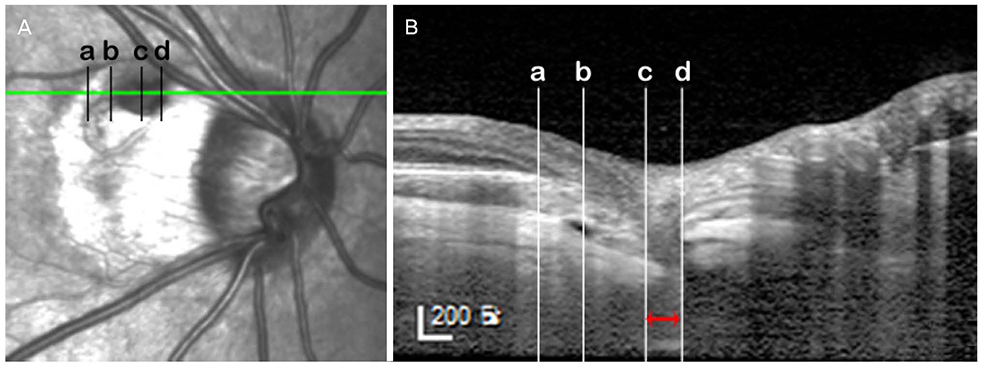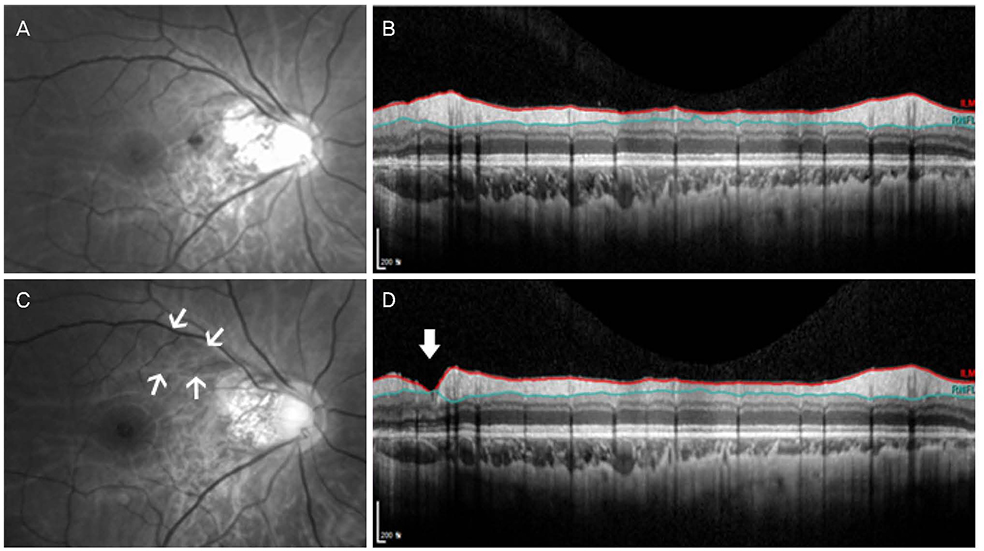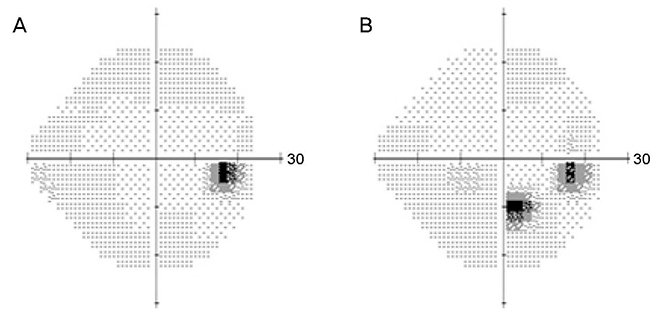J Korean Ophthalmol Soc.
2018 Jul;59(7):691-696. 10.3341/jkos.2018.59.7.691.
A Case of Retinal Herniation through Peripapillary Pit Resulting in Retinal Nerve Fiber Layer Defect
- Affiliations
-
- 1Department of Ophthalmology, Sanggye Paik Hospital, Inje University College of Medicine, Seoul, Korea. brio17@naver.com
- KMID: 2416274
- DOI: http://doi.org/10.3341/jkos.2018.59.7.691
Abstract
- PURPOSE
To report a case of glaucoma suspect with peripapillary pit, which enlarged in size with retinal herniation through the pit, and resulted in retinal nerve fiber layer defect and corresponding visual field defect.
CASE SUMMARY
A 34-year-old male was referred to our glaucoma clinic for glaucoma evaluation. The intraocular pressure was 15 mmHg in the right eye and 14 mmHg in the left eye. The refractive error in spherical equivalence was −12.75 diopters (D) in the right eye and −11.50 D in the left eye. The axial length was 28.70 mm in the right eye and 28.15 mm in the left eye. On optical coherence tomography (OCT), the retinal nerve fiber layer thickness was within normal limits in both eyes. A peripapillary pit was found in both eyes, which measured 155 µm in the right eye and 625 µm in the left eye in maximal horizontal diameters. Two year follow-up OCT images showed that the peripapillary pit in the right eye enlarged to 239 µm and retinal herniation occurred through the pit, resulting in a retinal nerve fiber layer defect and a corresponding visual field defect. However, the peripapillary pit in the left eye had no significant change.
CONCLUSIONS
Glaucoma patients or suspects, with peripapillary pits need close observation because of the possibility of a retinal nerve fiber layer defect in the direction of the pit.
MeSH Terms
Figure
Reference
-
1. Ohno-Matsui K, Akiba M, Moriyama M, et al. Acquired optic nerve and peripapillary pits in pathologic myopia. Ophthalmology. 2012; 119:1685–1692.
Article2. Ugurlu S, Weitzman M, Nduaguba C, Caprioli J. Acquired pit of the optic nerve: a risk factor for progression of glaucoma. Am J Ophthalmol. 1998; 125:457–464.
Article3. Lee EJ, Kim TW. Progressive retinal nerve fiber layer atrophy associated with enlarging peripapillary pit. J Glaucoma. 2017; 26:e79–e81.
Article4. Kranenburg EW. Crater-like holes in the optic disc and central serous retinopathy. Arch Ophthalmol. 1960; 64:912–924.
Article5. Dithmar S, Schuett F, Voelcker HE, Holz FG. Delayed sequential occurrence of perfluorodecalin and silicone oil in the subretinal space following retinal detachment surgery in the presence of an optic disc pit. Arch Ophthalmol. 2004; 122:409–411.6. Krivoy D, Gentile R, Liebmann JM, et al. Imaging congenital optic disc pits and associated maculopathy using optical coherence tomography. Arch Ophthalmol. 1996; 114:165–170.
Article7. Jonas JB, Nguyen XN, Gusek GC, Naumann GO. Parapapillary chorioretinal atrophy in normal and glaucoma eyes. I. Morphometric data. Invest Ophthalmol Vis Sci. 1989; 30:908–918.8. Jonas JB. Clinical implications of peripapillary atrophy in glaucoma. Curr Opin Ophthalmol. 2005; 16:84–88.
Article
- Full Text Links
- Actions
-
Cited
- CITED
-
- Close
- Share
- Similar articles
-
- Optic Disc Pit with Peripapillary Retinoschisis Presenting as a Localized Retinal Nerve Fiber Layer Defect
- Associations of Peripapillary Retinal Nerve Fiber Layer and Macular Retinal Layer Thickness with Serum Homocysteine Concentration
- Reproducibility of Retinal Nerve Fiber Layer Thickness Evaluation by Nerve Fiber Analyzer
- Biometry of Retinal Nerve Fiber Layer Thickness by NFA
- Changes in Macular Retinal Layers and Peripapillary Nerve Fiber Layer Thickness after 577-nm Pattern Scanning Laser in Patients with Diabetic Retinopathy





